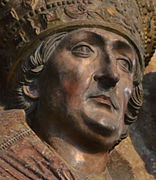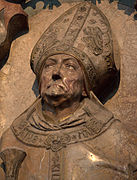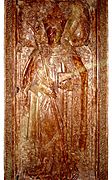Adnet marble

The Adneter marble is the trade name of a colorful, polishable limestone (" marble "). This rock is one of the so-called reef limestone and tuber limestone .
The designation of this natural stone as marble has historical roots and can therefore continue to be used. It is a type of rock that has a long tradition of use in Central Europe. Due to its different colors and décor, it was very popular as a building stone and monument. In addition to numerous baptismal fonts, columns, portals, pulpits and the late Gothic tomb art, the masterpieces by Veit Stoss , Tilman Riemenschneider and Niclaes Gerhaert van Leyden made of Adnet marble should be emphasized.
The rock deposit is located in Adnet , a municipality in the Salzburg region in the Hallein district in Austria. The marble quarries represent a separate location.
history
Already the Romans quarried the limestone from the 2nd century and used it for reliefs, building and profiled stone as well as mosaics . In Salzburg Museum three blocks of stone are issued with reliefs of this period. In the pre-Romanesque and Romanesque periods, this stone was mainly used to make relief designs. In the Gothic period, from around 1230, the "Adneter Scheck" was particularly important. The first written evidence of the existence of quarries dates from 1420. In the following times, the rock was in demand. Only in the period after the Second World War did demand drop sharply, which is reflected in quarry closures.
Origin and mineral inventory
The rock arose as deposits in the Mesozoic Era from calcareous shells and skeletons of dead animals as well as calcareous frameworks of plants in the sea; the so-called reef and coral limestone originated in the Triassic . The latter are referred to as drip marbles in Adnet .
This limestone consists predominantly of calcite , the crystallization forms of calcium carbonate (carbonate of calcium CaCO 3 ). Iron oxides occur in more or less fluctuating proportions , such as hematite , the reddish to red or limonite , which colors the Adneter rock yellow to brown.
Natural stone types
In the past, many Adnet farmers had their own quarry , nowadays only a small amount of Adnet marble is mined. There are a total of 10–20 quarries (some of them relatively hidden in the forest). Currently (2008) marble is only quarried in about five quarries.
In addition to regional aspects (Wimberg, Langmoos and the Kirchenbruch) in Adnet, the ownership structure gives its name to quarries: after the farmer Urban ( Urbano-Licht , or Urbano-Rosa ), a tuber limestone is named after the farmer Mozauer , after Schnöll Schnöllmarmor or Named Rotgrau-Schnöll . These forms of naming are traditionally common in all stone mining areas.
The so-called drip marbles are differentiated according to their color in light, red, gray, green or liver drip . The liver drop with a purple color is relatively rare.
Because of the typical pattern, some types of check marbles are named and the color is prefixed, such as red check and green check .
Significant sculptures
Significant works made of Adnet marble can be found in the parliament building in Vienna, on the Hohensalzburg fortress , in the collegiate church of St. Peter in Salzburg and in the New Reich Chancellery in Berlin. In numerous Austrian buildings, such as B. monasteries and monasteries are altars, epitaphs , coat of arms stones and tombs, such. B. in Melk , Klosterneuburg , Heiligenkreuz , Zwettl , Altenburg , St. Pölten , Lilienfeld , Mariazell , Graz , Eisenwurzen , Steyr , Kremsmünster , Lienz , Hallein etc. Furthermore, numerous historical baptismal fonts , wayside shrines and Marterl are made from this stone.
Veit Stoss and Tilman Riemenschneider , who carved a number of famous art-historical sculptures from wood in the Middle Ages, carved a few extremely remarkable stone sculptures from this stone. In particular, the facial features of the bishops in Würzburg Cathedral, masterfully created by Riemenschneider, show the stone carving depictions of people in the transition from the late Gothic to the Renaissance in an exemplary manner. Furthermore, the late Gothic masterpiece, the Tumba by Niclaes Gerhaert van Leyden of Emperor Friedrich III. in St. Stephen's Cathedral.
Renaissance style: Bishop Lorenz von Bibra in the cathedral of Würzburg by Riemenschneider
Late Gothic style: Bishop Rudolf II von Scherenberg in the cathedral of Würzburg von Riemenschneider
Tumba in St. Stephen's Cathedral in Vienna by Emperor Friedrich III. by van Leyden
Tombstone of Johannes Tulbeck from Rot-Scheck in the Frauenkirche Munich
Gravestone of the high grave of Hanns von Wulfestorff in the parish church Sitzendorf an der Schmida


Austria
- Parliament building (Vienna) : 24 fluted monolithic columns with a diameter of 1.10 m and a height of 8.50 m. The weight of the monolithic columns made of red-gray schnöll is around 18 tons each.
- Parish Church of Adnet : columns, altar, balusters , flooring
- St. Stephen's Cathedral in Vienna: Tumba of Emperor Friedrich III. His tomb in Vienna's St. Stephen's Cathedral by Niclaes Gerhaert van Leyden is one of the most important sculptural works of art of the late Middle Ages. There is also a late Gothic font, a fox canopy , the tumba for Duke Rudolf II and Duchess Katharina and the tabernacle on the main altar.
- Court church in Innsbruck : cenotaph of Emperor Maximilian I and columns
Germany
- Frauenkirche in Munich : Tomb slab of Emperor Ludwig IV the Bavarian and Johannes Tulbeck
- Bamba Cathedral Tumba from Emperor Heinrich II and Kunigunde from Tilman Riemenschneider
- Cathedral St. Kilian Würzburg : Tumba from Bishop Rudolf II. Von Scherenberg and Bishop Lorenz von Bibra from Tilman Riemenschneider
- Mariendom zu Freising : external portal (see picture)
- Marian column on Marienplatz in Munich: A monolith with a height of 5 m made of Rot-Scheck , which is the geodetic point of Bavaria and the place for the enthronement of the archbishops of Munich and Freising.
- Carmelite Church in Straubing: Tumba of Duke Albrecht II.
- Church of St. Zeno (Bad Reichenhall) : Main portal from the 12th century (Adneter and Untersberg marble ), the font from 1520 and the pulpit from 1522
- St. Lorenz Church in Nuremberg: epitaph by Kunz Horn
- Speyer cathedral : imperial monument (fragments)
Poland
- Wawel Cathedral in Krakow: Tumba and canopy of King Casimir Jagiello by Veit Stoss
- Gniezno Cathedral : Tumba of Bishop Zbigniew Oleśnicki by Veit Stoss
- Włocławek Cathedral : Tumba of Bishop Piotr z Bnina Moszyński by Veit Stoss
literature
- Alois Kieslinger : The usable rocks of Salzburg . Das Bergland-Buch, Salzburg et al. 1964 (= communications from the Society for Salzburg Regional Studies, supplementary volume 4).
- Alois Kieslinger, Salzburg marble in the art of two millennia . In. Negotiations of the Federal Geological Institute , special issue G, Vienna 1965, pp. 313–316. (also journal of the German Geological Society 116; pdf , geologie.ac.at).
- Franz Kretschmer: Marble from Adnet . Published by the Salzburger Bildungswerk, Örtliches Bildungswerk Adnet. Adnet municipal office, Land Salzburg, Adnet 1986, ( Adnet 1 home register).
- Marmorindustrie Kiefer AG (ed.): Memorandum on the development of the joint stock company for marble industry Kiefer in Kiefersfelden in the first twenty-five years of its existence, 1883-1908. Bruckmann, Munich undated (1908).
Web links
Individual evidence
- ↑ Franz Kretschmer, Heimatbuch, p. 20, see Lit.
Coordinates: 47 ° 42 ′ 3 ″ N , 13 ° 8 ′ 35 ″ E







